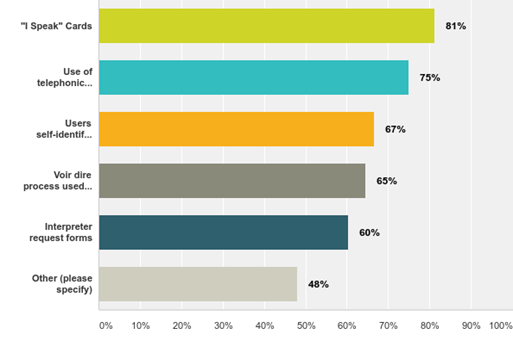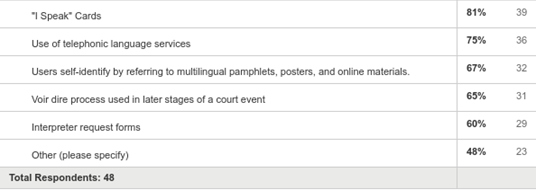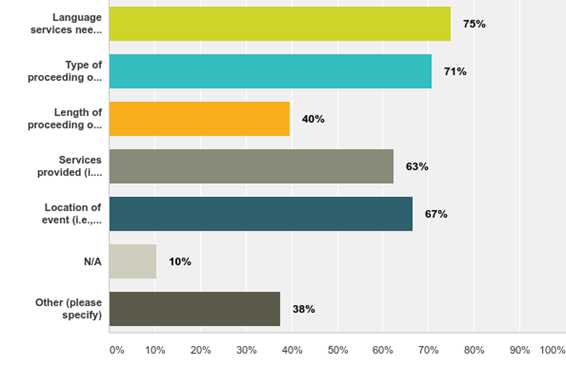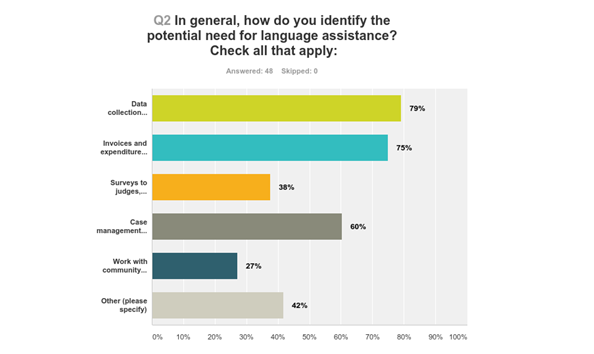Establish data collection and analysis procedures to assist with the identification of need for language assistance at all points of contact.
Identifying the need for language assistance is a fundamental component of any language access program. Jurisdictions should regularly assess the actual and potential need for language assistance to facilitate the development of an LAP and to improve language services. Action Step 1 details three main areas to help states identify the need for language access services: identifying the need for language assistance in the court; identifying the need at all points of contact; and the types of data to collect.
At the Summit, there was a consensus among participants and presenters that a vital initial step toward improving language access services was to establish or improve procedures for identifying the need for language assistance. In their Action Plans, the states detailed proposals to utilize demographic information to assist with forecasting potential language needs and to establish data collection and analysis protocols and systems to review actual language use and services in the courts.
Over the past 5 years, jurisdictions have improved their methods of identifying the need for language assistance, by establishing effective data collections and analysis procedures. States and territories have gone well beyond merely relying on demographic data, they also are establishing case management systems, increasing efforts to work with community organizations to monitor fluctuating populations, and are fully utilizing their internal information available to courts, such as invoices and expenditure reports.
In NCSC’s recent survey, the responses revealed that jurisdictions have employed various effective methods of identifying the need for language assistance. NCSC posed a series of questions to determine the methods jurisdictions have been utilizing to identify the need accurately and efficiently.
Methods for Identifying the NeedThe first question asked how jurisdictions identify the potential need for language assistance. The most commonly utilized methods were: data collection pertaining to language assistance requests; invoices and expenditures reports pertaining to language services provided; surveys to judges, attorneys, and court staff; case management systems capture needs, such as coding and flagging; and working with community organizations to conduct demographic assessment. (Fig. Q2.)
In addition to the most commonly used methods listed above, jurisdictions provided details in response to this survey question on other types of methods they use to identify the need. Other methods included, collecting demographic data, maintaining communication, developing case management systems, and program-wide data collection projects. A number of states detailed their use of demographic information, including U.S. and state census data. Demographic data at the county, state, and national levels can assist with planning for anticipated and changing needs. This data can facilitate with planning efforts, including recruitment and training of interpreters or bilingual staff in certain languages and the development for translated materials or signage.
Demographic information
- The Alaska Court system reviews demographic information from the U.S. Census Bureau, The Alaska Department of Labor and Workforce Development, Alaska school districts, and the Language Interpreter Center. The statewide Language Services Coordinator tracks language needs by reviewing data collected on a monthly basis.
- In Hawaii, the State Judiciary implemented the LEP Language Access Data Collection Project. The goal of the project is to identify populations with LEP that are eligible to be served by the state courts and ensure the provision of language access services in a culturally and linguistically appropriate manner to eligible LEP language groups.
- U.S. Census data.
- State Demographer, school enrollment.
- Biennial reviews of U.S. Census Data, North Dakota Chamber of Commerce Data, ND Population data compiled by ND State University, and data provided by Lutheran Social Services for ND which is the federally designated agency responsible for refugee resettlement in ND.
- Economic Development Research Information Center and census data.
Direct Communication and Feedback
- Regular communication with district court administrators and their designated court interpreter coordinators.
- Individual discussion with court interpreter schedulers at largest jurisdictions.
- Community outreach.
- Specific language requests from courts and probation services.
- Early identifiers from stakeholders such as police reports, victim’s advocates, etc.
- Contacts to the Supreme Court regarding our certified and qualified interpreter and firm list.
Case Management Systems
- Arizona is a non-unified system. Courts at the local level are responsible for identifying language assistance needs. However, state-supported case management systems include coding/flagging functionality.
- Developing case management system captures needs.
Points of Contact
The second survey question in this area focused on identifying the need at all points of contact.
Jurisdictions report in the survey that they have established a variety of effective protocols to improve their ability to identify the need for services in all courtroom locations, as well as outside of the courtroom.
Most jurisdictions utilize a combination of methods. States most commonly use “I Speak” cards and telephonic language services. Users will also self-identify by referring to multilingual pamphlets, posters, and online materials. They also use interpreter request forms and the voire dire process.
Q3: “With specific users, how do you identify the need for language assistance at all points of contact?”


In addition to the methods listed above, jurisdictions added additional ways in which they effectively identify the need of LEP users at all points of contact. Methods include: bilingual staff, signs, initial filing documents, and requests from attorneys, friends, or advocates. Some jurisdictions report that because they are decentralized they must employ multiple processes at various points of contact in order to effectively identify LEP users.
Bilingual staff
- We have trained and certified over 100 Language Access Specialists in Spanish, Navajo, Mandarin, Polish and Keres. These are bilingual employees who provide language access services outside the courtroom such as self-help centers, customer service, clerk's office, etc.
- Bilingual court staff to assist (for example, counter); Model notice of available language access services.
Visuals and Signs
- Large globe poster that advises litigants about broad range of services.
- Language Identification Posters that include "I Speak" cards and flags of several countries allow for an easier language identification process.
Initial Filing Documents
- Initial filing documents such as landlord/tenant Interpreter approaching and establishing communication with party in duty courtrooms; multilingual signage at the jail video kiosk for court appearance; notifying of availability of free interpreting services; jail intake forms that are transferred to the court.
- Initial filing forms via paper or ECOURTS ask if interpreting services are needed and if so in what language.
Requests made by Attorneys, Family, Friends, Advocates and Law Enforcement
- Attorneys make requests directly to the courts and the courts request the interpreter service to our office. If there is any doubt we confirm the language before contracting the interpreter.
- LEP individual appears with friend or family member who speaks English, and courts or probation services identify need for language assistance and seek assignment of a qualified interpreter.
- Individuals arrive at the court, often with a family member or friend to serve as a translator, and it is apparent that an interpreter is needed to engage in conversation with them; law enforcement or prosecution will notify the court that an interpreter is needed prior to the 1st appearance on a criminal charge; a caseworker will notify the court that an interpreter is needed if the family has been receiving services through Human Services and they are aware that a case has been filed that involves a member of the family who needs those services.
- Attorneys whose LEP clients or witnesses need interpreters -- or a family member or friend of a self-represented LEP party -- contact the clerk of court or district court administrator's office to request appointment of an interpreter. If an LEP person comes to the clerk of court office, clerk staff use a telephone interpreter service to communicate with the LEP person.
Miscellaneous
- Under a U.S. Department of Justice grant, the Hawaii State Judiciary developed Language ID Cards in 14 non-English languages frequently encountered in the state courts, including a number of "rare" Asian and Pacific Island languages. Hawaii State Judiciary staff has been trained on how to identify potential limited English proficient (LEP) court users, and to affirmatively offer language services if there are any perceived communication difficulties. Note: Interpreter request forms were developed under an ABA grant to the Hawaii Access to Justice Commission, to provide a means by which LEP persons can notify the court of their language need before their first hearing date. The judicial circuits are working on implementation planning and procedures for processing the Interpreter Request Forms, prior to public release of the form.
- As the Florida State Court System is decentralized, practices may vary between jurisdictions. The majority of jurisdictions use more than one means of identifying language access assistance. At a minimum, such means typically include interpreter request forms and voir dire processes. A link to “I Speak” Cards is also included in the judicial bench card for spoken language interpreting services.
Data Collection & Tracking Language Services Usage
An important component of identifying the need for language services is tracking the actual use of language services inside and outside of the courtroom. Based on the survey results, we see that jurisdictions recognize the importance of collecting data on the actual use of language services. A majority of jurisdictions collect data on language services. Out of 48 respondents, 43 reported that they collect data that tracks language services usage. (Fig. Q4.)
The top information that jurisdictions collect is the language services needed and requested and also the type of proceeding for which assistance was provided. They also collect data on the location of the event, the services provided, and the length of the proceeding or event.
Q4 “If you collect language access data, what kind of data do you collect?”

Jurisdictions report that they collect the following additional data, which was not captured in the listing above:
- Accounting of annual cost per language, statewide Accounting of annual cost of remote interpreting provided by vendor(s) Number of remote interpreting events Number of forms and correspondence translated annually Unused services: Interpreter cancellation expenses Number of requests for LEP victims Number of last minute requests (by requestor/language) RI User Satisfaction Surveys Legislative Performance Measures: % of events interpreted by a Certified interpreter.
- The trial courts report provision of select interpreter services data on a monthly basis to the OSCA, by circuit, via the Uniform Data Reporting instrument. Reported data compiled and maintained in a central repository includes number of translation pages, length of proceeding, type of proceeding, and whether the language demand was Spanish, Haitian Creole, Other, or Sign Language.
- The Hawaii State Judiciary's LEP/Language Access Data Collection Project also reports the number of languages services, the number of proceedings/encounters in which languages were provided, and the cost.
- Arizona's is a non-unified system. Courts at the local level are responsible for collecting data. Most track languages requested. Others also track type of proceeding, services provided, location, etc.








